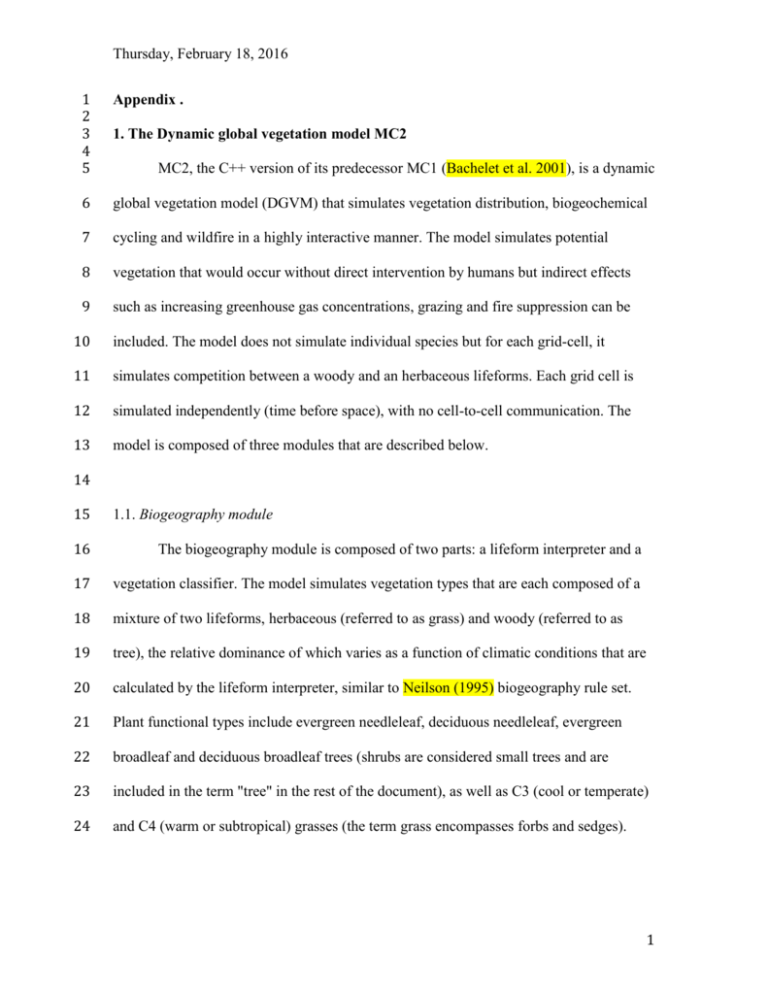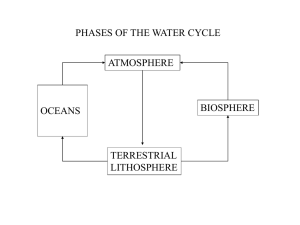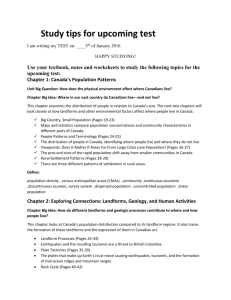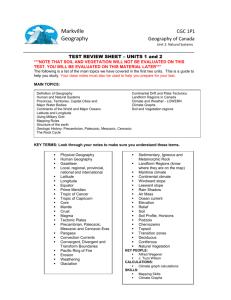gcb13048-sup-0002-Appendix
advertisement

Thursday, February 18, 2016 1 2 3 4 5 Appendix . 6 global vegetation model (DGVM) that simulates vegetation distribution, biogeochemical 7 cycling and wildfire in a highly interactive manner. The model simulates potential 8 vegetation that would occur without direct intervention by humans but indirect effects 9 such as increasing greenhouse gas concentrations, grazing and fire suppression can be 1. The Dynamic global vegetation model MC2 MC2, the C++ version of its predecessor MC1 (Bachelet et al. 2001), is a dynamic 10 included. The model does not simulate individual species but for each grid-cell, it 11 simulates competition between a woody and an herbaceous lifeforms. Each grid cell is 12 simulated independently (time before space), with no cell-to-cell communication. The 13 model is composed of three modules that are described below. 14 15 1.1. Biogeography module 16 The biogeography module is composed of two parts: a lifeform interpreter and a 17 vegetation classifier. The model simulates vegetation types that are each composed of a 18 mixture of two lifeforms, herbaceous (referred to as grass) and woody (referred to as 19 tree), the relative dominance of which varies as a function of climatic conditions that are 20 calculated by the lifeform interpreter, similar to Neilson (1995) biogeography rule set. 21 Plant functional types include evergreen needleleaf, deciduous needleleaf, evergreen 22 broadleaf and deciduous broadleaf trees (shrubs are considered small trees and are 23 included in the term "tree" in the rest of the document), as well as C3 (cool or temperate) 24 and C4 (warm or subtropical) grasses (the term grass encompasses forbs and sedges). 1 Thursday, February 18, 2016 25 The tree phenology and leaf morphology are determined at each annual time step 26 as a function of the minimum temperature of the coldest month (minimum Tmin) and of 27 the growing (i.e. warm) season precipitation that have been smoothed over 15 years. The 28 smoothing function progressively diminishes the influence of each past year’s climate on 29 the smoothed climate variables to take into account the inherent inertia of long-lived 30 woody types to short-term climate variability (Daly et al. 2000). 31 The C3/C4 grass functional types are determined by the ratio of C3/C4 grass productivity, 32 which depends on the temperature of the three consecutive warmest months, subject to 33 the same 15-year climate smoothing function. Warmer temperatures favor C4 grasses. 34 The balance between trees and grasses is determined by simulating the 35 competition between these two lifeforms for light, water and nutrients, as mediated by 36 fire. The resulting biomasses along with smoothed climate thresholds are used in the 37 vegetation classifier to define the vegetation types. There are 36 vegetation types 38 available for the globe, each defined by the association of a tree/shrub and either a C3 or 39 a C4 grass. High latitude vegetation types are defined by growing degree-days that define 40 their climate zone. 41 42 43 1.2 Biogeochemistry module The biogeochemistry model is a modified version of the CENTURY model 44 (Metherell et al. 1993, Parton et al. 1994) that simulates the cycling of carbon and 45 nitrogen among plant parts, multiple classes of litter, and soil organic matter pools. Live 46 and dead plant components include leaves, fine and coarse branches, fine and coarse 47 roots. Dead herbaceous material composes the standing dead compartment. Dead plant 2 Thursday, February 18, 2016 48 material is transferred to aboveground or belowground litter compartments that 49 decompose into three soil carbon pools of increasingly slower turnover rates, releasing 50 CO2 fluxes defined as heterotrophic respiration as described in Century model (Metherell 51 et al. 1993). Decomposition rates are influenced by soil texture, soil moisture and 52 temperature, as well as the existing soil carbon content and the nutrient content of the 53 dead material. 54 Tree and grass production rates are based on maximum monthly rates that are 55 interpolated between lifeform-dependent parameter values, depending on the mixture of 56 tree and grass functional types set by the biogeography module. For example, the climate 57 indices may indicate 25% deciduousness so the model calculates a production rate that 58 takes the weighted average of deciduous tree productivity (x0.25) and evergreen tree 59 productivity (x0.75). The maximum production rate thus obtained is then multiplied by 60 limiting-factors scalars related to temperature, soil available water, and atmospheric CO2 61 that differ for trees vs. grasses (Bachelet et al. 2001). In the case of trees, a scalar related 62 to leaf area index (LAI defined as one-sided leaf area per unit ground area), is added to 63 address self-shading in estimating the fraction of incoming light intercepted by trees. For 64 grasses, scalars incorporating the effects of shading by trees and standing dead grass are 65 also included. The temperature scalars are based on mean monthly surface soil 66 temperature, as affected by canopy shading and reduction of outgoing long-wave 67 radiation (Parton et al. 1994). Allocation algorithms distribute carbon and nitrogen to 68 various plant parts following the same logic as in the CENTURY model (Metherell et al. 69 1993, Parton et al. 1994). 3 Thursday, February 18, 2016 70 The model includes a fertilization effect of elevated atmospheric CO2 71 concentration that enhances water use efficiency (~8% reduction of transpiration and 72 ~8% increase in NPP at 550ppm). 73 The biogeochemistry module also simulates actual and potential 74 evapotranspiration (AET and PET) and soil water content in multiple soil layers, the 75 number of which depends on the total soil depth that is an input to the model. Tree leaf 76 and grass moisture contents are calculated as functions of the ratio of tree or grass 77 available water to PET. These are interpreted as live fuel moisture contents by the fire 78 module and affect fire behavior. 79 80 81 1.3 Fire module The fire module simulates the occurrence, behavior and effects of fire and was 82 originally designed to project the large, severe fires that account for the bulk of observed 83 fire impacts in the conterminous U.S. (Lenihan et al. 1998 and 2008, Conklin et al. 84 2015). The module includes a set of mechanistic fire behavior and effects functions 85 (Rothermel 1972; Peterson and Ryan 1986; van Wagner 1993) embedded in a structure 86 that enables two-way interactions with the biogeochemistry and biogeography modules. 87 Live and dead fuel loads in 1-hr, 10-hr, 100-hr and 1000-hr fuel classes are estimated 88 from the carbon pools simulated in the biogeochemistry module. Allometric functions 89 relate tree carbon pool sizes to height, crown base height and bark thickness for an 90 average-sized tree. Empirical parameters are used to determine when crown (as opposed 91 to surface) fires occur and project fire effects on vegetation (mortality only versus 92 biomass consumption and emissions). 4 Thursday, February 18, 2016 93 The moisture content of the different fuel classes and the potential fire behavior 94 are calculated each day based on pseudo-daily data interpolated from the monthly climate 95 inputs. For temperature and relative humidity, a linear interpolation between monthly 96 values is used to generate daily values. For precipitation, the number of precipitation 97 events is estimated with a regression function derived from weather station data archived 98 by the National Climate Data Center (Lenihan et al. 1998). Monthly values are divided by 99 the number of precipitation events per month and resulting values are randomly assigned 100 to days within each month. Moisture contents of plant parts passed from the 101 biogeochemistry module determine live fuel moisture contents. A combination of the 102 Canadian Fine Fuel Moisture Code (Van Wagner and Pickett 1985) and the National Fire 103 Danger Rating System (Bradshaw et al. 1983) is used to estimate dead fuel moisture 104 contents. 105 Potential fire behavior (including rate of spread) is calculated each day based on 106 daily-interpolated fuel loads, moisture contents and weather. Potential fire behavior is 107 modulated by vegetation type, which affects fuel properties and realized wind speeds 108 (e.g. higher for grasslands than forest). Actual fire is simulated whenever the calculated 109 rate of spread is greater than zero and user-specified thresholds are exceeded for the fine 110 fuel moisture code (FFMC) and the build up index (BUI) of the Canadian fire weather 111 index system. These two indices are inverse functions of fine fuel and coarser fuel 112 moisture contents, respectively, as specified by Van Wagner and Pickett (1985). Only 113 one fire is simulated per year per cell on the first day when all thresholds are exceeded. 114 Note that the day and year of fire may vary from cell to cell, given the independent 115 simulation of each cell. 5 Thursday, February 18, 2016 116 Rogers et al. (2011) added an algorithm to MC1 to simulate fire suppression using 117 thresholds for three fire intensity metrics: rate of spread (ros), fireline intensity (fli), and 118 energy release component (erc). 119 120 2. Input data 121 2.1. Soils 122 The MC2 model requires inputs of soil depth, texture and bulk density. Soils data 123 from Kern (1994; 1995; 2000) were obtained from Dr. Ray Drapek (USFS PNW) who 124 reprojected the original 1km data to a 30 arc-second grid using the “majority” rule such 125 that the soil-related value that occupies the majority of the area of a particular grid-cell 126 gets assigned to the entirety of that grid-cell. 127 Available gridded soil datasets for the USA include “no soil” values for peatland 128 as well as locations currently under glacier/snow. For historical runs, we can simply mask 129 out those gridcells but for runs into the future there is high probability that permafrost 130 would melt and high elevation peatlands will dry up is real (Turetsky et al. 2011). At 131 lower elevations and/or latitudes such as in Florida, decreases in precipitation and 132 increased evapotranspiration has already caused extensive subsidence of native peatlands 133 (e.g. Aich and Dreschel 2011) when they are being drained for agriculture. While the 134 current model version cannot simulate peatland processes, it will simulate vegetation 135 shifts where snow/ice disappears following warming but because we do not calculate the 136 water budget of warmer latitude peatlands we do not simulate the invasion of drying 137 peatlands by terrestrial vegetation. The Harmonized World Soil Database (HWSD) that 138 includes a variable called "topsoil organic carbon" was used to both to distinguish high 6 Thursday, February 18, 2016 139 elevation/latitude peatland (that we simply masked) from ice/snow fields and to fill in 140 soil attributes for the latter. In western states (Rocky mountains and westward), lakes 141 (Great Salt Lake, Klamath Lake, Salton Sea, etc) were also masked. 142 143 2.2. Climate 144 Historical Climate 145 Climate inputs to the model include monthly precipitation, mean vapor pressure 146 or dew point temperature, and mean daily maximum and minimum temperatures 147 averaged over each month. Historical climate data (1895-2010) were acquired from the 148 PRISM group at Oregon State University (Daly et al. 2008) at 30 arc-second. 149 150 151 Future Climate Future climate projections (2010-2100 and 2006-2100 for the land-use runs) were 152 originally acquired from the WCRP (World Climate Research Programme) CMIP3 153 (Coupled Model Intercomparison Project phase 3) multi-model database website 154 (https://esg.llnl.gov:8443/home/publicHomePage.do). The three IPCC SRES A2, A1B 155 and B1 greenhouse gas emission scenarios (Nakićenović et al. 2000) and three GCMs 156 bracket the projected range of temperature increases across the U.S.: CSIRO Mk3.5 157 (Gordon, 2010), CGCM3 (Flato et al. 2000) and MIROC 3.5 medres (Hasumi & Emori, 158 2004) (henceforth CSIRO, CGCM3 and MIROC). 159 160 For each climate variable and each future month, anomalies between future and mean monthly historical (baseline: 1971-2000) GCM climate were calculated for each 7 Thursday, February 18, 2016 161 GCM grid cell over the conterminous U.S.. Differences were used for temperature and 162 ratios for precipitation and vapor pressure (capped at a maximum value of five). 163 164 Note: The MC2 model, like MC1, also requires annual ambient CO2 associated with both 165 historical and each of the future emission scenarios. These data were provided by R. 166 Stouffer (pers. comm.). 167 168 Strided Input Data 169 We created "strided" or sub-sampled input datasets where regularly spaced 170 samples were taken in both latitudinal and longitudinal dimensions. We sub-sampled the 171 30 arc-second (~800m) dataset to a resolution of 5 arc-minutes using a stride of 10 (every 172 10th row and every 10th column). This subset is able to represent the conterminous U.S. 173 in a 691 x 297 grid and have a higher probability of including the observed variability in 174 climate values than would interpolation or aggregation of values to the coarser grid. The 175 resulting subset is similar in appearance to a high-resolution dataset, hence allowing 176 visual verification of the model results. Samples spaced at 5 arc-minutes in both 177 dimensions provide a reasonable compromise of size (hence speed) and inclusion of 178 representative data. This sub-sampled dataset allowed multiple runs for calibration 179 purposes and ensured reasonable time for processing results and generating model runs to 180 2100 to further evaluate trends in C cycle dynamics. When results of the full-resolution 181 (30 arc sec) simulations were compared with the strided results, regional summaries were 182 virtually identical. Consequently they were used to generate summary statistics. 183 8 Thursday, February 18, 2016 184 185 2.3. On-the-fly Downscaling Because of the size of the input data and the number of combinations of models 186 and emissions scenarios to run, storing all of the downscaled input climatologies (~1.5TB 187 of storage) has become a challenge. We developed a system of "on-the-fly" downscaling, 188 in which we stored anomalies of all the climate variables at the GCM resolution, along 189 with values of the historical climate for the same baseline period at the 30 arc-second 190 resolution. The GCM resolution is sufficiently coarse that the anomalies require only a 191 small amount of disk space. This allowed efficient bias-correction downscaling by simply 192 interpolating the GCM anomalies to the 30 arc-second grid and adding (or multiplying 193 by) the historical PRISM (Daly et al. 1994) monthly baseline climate (1971-2000) at that 194 same scale. The downscaled future climate was produced as temporary files, which were 195 discarded upon completion of the model run. 196 On-the-fly downscaling required an efficient interpolation routine that included an 197 algorithm used for interpolation. Since interpolation can be viewed as an example of 198 sampling, it can be approached using the very substantial body of known practices used 199 in digital signal processing. A key result in that field is the Shannon-Nyquist sampling 200 theorem, which describes the conditions under which artefacts (aliasing) can be 201 introduced into sampled data. Many commonly used interpolation algorithms, such as 202 bilinear and splined interpolation, can introduce such artefacts. Consequently we 203 developed an interpolation routine (C++ in-house program) with a Gaussian interpolation 204 filter, avoiding aliasing, with the filter size set according to the resolution of each GCM 205 dataset. 206 9 Thursday, February 18, 2016 207 208 2.4. Land use To initialize vegetation cover, a USGS land-use file (Sohl et al. 2012 and 2014, 209 Sleeter et al. 2012) was used as input, whereby MC2-generated potential vegetation 210 categories were replaced by new categories (developed, agriculture, mining, managed 211 forests - see Table 1) where the input data indicated a managed vegetation type. Because 212 the land-use time series started in 1992, the model was run with potential natural 213 vegetation with fire suppression until 1991 and only then was initialized with land-use. 214 Because projected future land-use based on the SRES emission projections (Nakićenović 215 et al. 2000) started in 2006, future climate projections were used starting in 2006 for the 216 land-use runs. 217 218 219 3. Run protocol The DGVM runs in three distinct phases producing results that are used as input 220 for the next phase. First, the static biogeography model MAPSS (Neilson 1995) uses 221 monthly mean climate (historical averages for 30 years, 1895-1924) to generate a map of 222 potential vegetation distribution. During the second part of the equilibrium phase, the 223 DGVM biogeochemistry module uses the same average climate iteratively to calculate 224 the size of the carbon and nitrogen pools associated with each vegetation type for each 225 grid cell while allowing for prescribed vegetation-specific fire return intervals. The 226 equilibrium phase ends when the resistant soil carbon pool size changes by less than 1% 227 from one year to the next. Consequently the duration of this phase varies across the map 228 depending on the type of vegetation cover (from a few decades in the Great Plains 229 grasslands up to 3000 years in the rain forests of the Pacific Northwest). 10 Thursday, February 18, 2016 230 During the 2nd, spinup phase, the model is run, also iteratively, using a detrended 231 monthly historical climate time series (1895 to 2009) to capture the interannual 232 variability and allow for readjustments of vegetation type and carbon pool sizes in 233 response to dynamic wildfires. The time series is adjusted such that the climate variable 234 means match the first 30 years of the historical period (1895-1924) and allow for a 235 smooth transition between spinup and transient historical climate. The spinup phase ends 236 when the net biome production (net ecosystem production minus carbon consumed by 237 wildfire) reaches an equilibrium state near zero (600 years for this project). 238 During the third, transient phase, the model is run first with a time series of 239 historical climate data starting in 1895 and then, starting in 2006 and ending 2100, with 240 future climate projections available from regional or global climate models that include 241 both interannual variability and long-term trends. 11








